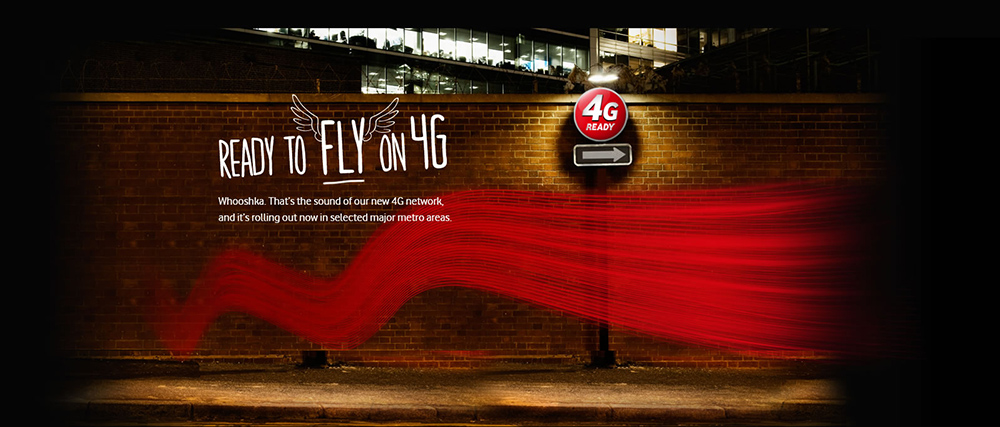
Ausdroid has had the privilege of playing with Vodafone’s 4G network for the last week. Here’s what we found.
Late last week, Vodafone approached us and asked Ausdroid would like to take part in a secret project. With not much more information than this, we of course accepted, and within a short while we found out we’d have a (relatively) exclusive opportunity to have a play with Vodafone’s new 4G/LTE network before it became open to the general public. We were invited to take a trial device, travel around wherever we wanted, and see how the network performed.
I have to say, I’ve been impressed. Sitting here at my desk typing this review, I don’t have 4G. This isn’t all that surprising; Hornsby is considered the northern fringe of the Sydney metropolitan area, and it was only recently (maybe the last month or so) that Telstra’s 4G coverage extended up this far. For a brand new network, I wouldn’t expect there to be 4G here, just yet. However, it wasn’t long ago that my partner had an iPhone 5 on Vodafone, and had slow, unreliable signal in our apartment, to the point that the iPhone was returned and the contract cancelled.
I was, perhaps understandably, a skeptic. I’ve been burned by Vodafone before, and unfortunately for Vodafone, my experiences of the past have hardly been unique. Over the past couple of years, Vodafone has received a bit of negative publicity centring — largely — on the inadequate performance of their network. It was this experience (back in 2010) that moved me to sign with Telstra, and I’ve been there since.
However, Vodafone’s network has changed quite a bit since those times, and as a bit of time has passed, I was prepared to approach this with an open mind.
While I don’t have 4G at home, Vodafone’s network is giving me a strong HSPA+ network connection, which is performing nice and swiftly at a respectable 5.6mbps downstream, 1.3mbps upstream and only 69ms latency. Using the same network connection, my HTC One on Telstra is achieving a slightly faster downstream rate of 9.8mbps, a slightly slower upstream rate of 1mbps, and a slightly quicker latency of 48ms. In real world usage, there’s very little between the two.
Flick the Telstra handset over to LTE and repeat, and the results are curiously not much different — 12.8 mbps down and 2.85 mbps up, and latency the same at 50ms. We’re in a fringe area here, and as soon as I move somewhere with stronger signal, Telstra’s performance really opens up the taps. Speeds of up to 30 mbps in either direction are not uncommon.
To my mind, Vodafone had to be able to match this to be a worthy contender. Let’s see how they went.
- 4G speeds can be fast, and I mean damned fast. I’ve seen speeds up to 65mbps downstream. Insane.
- Performance was at least on par with that observed on Telstra, and in many instances, better.
- Coverage is surprisingly good, considering this is a newly launched network. I expected less.
- Improvements to Vodafone’s 3G and 3GPlus networks are obvious; the coverage there is awesome and rather fast too.
- Network performance was inconsistent; in some places, 4G/LTE was slower than 3G, and while downstream speeds were fast, upstream speeds were slower — the fastest was 22mbps, and the average was around 6mbps.
- Coverage wasn’t everywhere I wanted it. Not at home, and not at work in the Sydney CBD. However, it wasn’t far away.
Coverage
During my limited time with Vodafone 4G, I tried to get around a good few areas of Sydney, predominantly around the north shore and north west, but I managed to work in a few trips to the office and out to south western Sydney, and I have to say I found 4G coverage in most places. In those areas that there wasn’t 4G, I had virtually continuous 3G/HSPA+ coverage with fairly quick network performance. I wasn’t able to find anywhere that Vodafone’s network completely failed on me, certainly not in places that it had done in the past, including right here at home. This certainly boded well.
Everywhere I went, I had good performance, both for voice and data usage. This really shouldn’t be remarkable, and it isn’t — in my mind, a network that can’t deliver these things isn’t even worth talking about, and indeed, it’s only notable in reviewing a network service when these things don’t work.
I’ve prepared a map of the speed tests I conducted (you can see these results below) so you can get an idea of what tests were performed where. This should give you a reasonable picture of Vodafone’s real-world 4G coverage in and around Sydney:
View our Vodafone 4G performance map in a full screen map
Carrying around two phones for the past week has been a bit of a chore, but it has allowed me to do a direct comparison between Vodafone’s network and Telstra’s at whim, and I don’t think I’ve come across any situations where I could honestly say I was disappointed with the Vodafone service. Telstra is far from a benchmark, and their network is known for its own issues, but it certainly provides a good point of comparison. In most places that Telstra had 4G coverage, so did Vodafone, with one or two exceptions. In most places that Telstra didn’t have 4G, neither did Vodafone, though there were a few places where Vodafone did and Telstra didn’t. Equally, there were a good few places (including home and work) where Telstra had 4G service and Vodafone didn’t.
The beauty here is that Vodafone offers its new and upgrading customers a network guarantee, and so once the 4G network becomes available to new signups in July, you can sign up for a Vodafone 4G service and try it out in the places that matter to you. If you don’t get 4G at home or work, and you’re expecting to have that, then you can cancel the contract and had it back. Simple.
Telstra, on the other hand, advertise no such service. Then again, they probably don’t need to.
Speed
Vodafone’s own advertising material suggests that their 4G network should best those of Telstra and Optus. Why? Simply put, they have more bandwidth. They state:
Vodafone’s unique 2 X 20MHz contiguous spectrum holdings mean the company is among the first in the world to offer these speeds, outpacing competitors in all of the five mainland capital city areas today. Launching in selected metro areas of Sydney, Perth, Melbourne, Adelaide, Brisbane; and Newcastle and Wollongong, Vodafone’s wide-band 4G network is set to treble by year’s end.
Contrast this with Telstra, which has between 10 to 20 MHz of spectrum in its coverage, and Optus which has around 15 MHz (depending on site), and you can immediately see that with up to 40 MHz of spectrum to play with, Vodafone has an advantage. But all this talk of megahertz and megabits is a bit dull. What really matters is how fast your service is and what it means for you, and in this, Vodafone’s 4G network is kind of rad.
Consider this table below which shows the download time for a 100 megabyte file on various network technologies. While 4G LTE isn’t the fastest, if you exclude a 100 Mbit LAN connection — which, let’s face it, you can’t carry around with you everywhere — LTE is looking damned impressive, faster than most home network connections:
| Connection type | Download speed | Download time |
|---|---|---|
| Modem | 28.8 kbit/s | |
| Modem | 56.6 kbit/s | |
| ADSL | 256 kbit/s | |
| ADSL | 512 kbit/s | |
| ADSL | 1 Mbit/s | |
| ADSL | 2 Mbit/s | |
| ADSL | 8 Mbit/s | |
| ADSL | 24 Mbit/s | |
| LAN | 10 Mbit/s | |
| LAN | 100 Mbit/s | |
| Turbo 3G | 7.2 Mbit/s | |
| Vodafone 4G | 50 Mbit/s |
This table isn’t just fanciful, it’s fact. These kind of speeds to bear out, and they are accessible and available to users of Vodafone’s 4G network in most places that it’s available. I conducted some 35 speedtests across a number of sites aorund greater metropolitan Sydney, and my findings are summarised below:
Vodafone Network Performance
| Downstream Speed | Upstream speed | Latency | |
|---|---|---|---|
| Minimum | 1.79 mbps | 0.04 mbps | 920 ms |
| Average | 27.27 mbps | 6.67 mbps | 103 ms |
| Median | 22.09 mbps | 4.22 mbps | 55 ms |
| Maximum | 63.53 mbps | 22.85 mbps | 23 ms |
Note: With speed, bigger is better. With latency, lower is better.
Compared with Telstra 4G
For comparison, I achieved the following results from Telstra from a smaller sample set (around 16 tests) because I wasn’t really out to test Telstra’s network, I just wanted a bit of a comparison point.
| Downstream Speed | Upstream speed | Latency | |
|---|---|---|---|
| Minimum | 5.13 mbps | 0.24 mbps | 69 ms |
| Average | 24.53 mbps | 11.50 mbps | 44 ms |
| Median | 20.77 mbps | 12.59 mbps | 40 ms |
| Maximum | 54.76 mbps | 23.65 mbps | 32 ms |
As you can see from these two tables, there’s a few observations that are fairly obvious:
- Vodafone had a higher maximum speed – 63.53 mbps compared to 54.75 mbps on Telstra
- Vodafone’s average download speed was higher – 27.27 mbps vs 24.53 mbps on Telstra
- Vodafone’s upload speeds were lower across the board — an average of 6.67 mbps vs a higher 11.50 mbps on Telstra
In real world usage, what does this mean? Simply put, where you’ve got Vodafone 4G coverage, there’s a fairly good chance that you’re going to have excellent data speeds, that are at least as good as Telstra’s 4G network (which has been operating for at least twelve months), and in many instances, better. Where Vodafone’s network falters is in upload performance, and this is going to hurt if you’re uploading video files to Youtube or sending large emails. With today’s smartphones, it’s so easy to shoot videos and high-res photos when you’re out and about, and there’s a multitude of ways to share this content with people. With lower upload speeds, sharing this content is going to take longer. However, there’s a reality check required here.
A 50 megabyte video is going to take around 38 seconds to upload, assuming ideal network conditions, on a 11 megabit upload pipe. On a 6 megabit pipe, the same upload will take a little over a minute. Yes, in a numerical sense, it’s almost twice as long. In reality, it doesn’t really matter if your upload takes 30 seconds or a minute. Either way, you’re still uploading a large file very, very quickly, and in many instances, a hell of a lot faster than you’d be uploading it if you waited until you got home and uploaded via your home internet connection.
Still, I digress.
The reality is simple — Vodafone’s 4G network is damned fast, and deserves its buzzword of ‘whooshka’.
Vodafone
- 2G – Covers 94.5% of the Australian population
- 3G – 850 MHz – covers a lot of places
- 3G – 900 MHz – so does this!
- 3G – 2100 MHz – covers mainly metro areas
- 4G – 1800 MHz – 4G/LTE network that we tested
Want to see what kind of networks operate in your area? Check out Vodafone’s coverage checker.
The deployment of Vodafone’s 4G network brings it on a level footing with Telstra and Optus, at least on a technological basis. While our initial tests show it to be a speedy network, it’s worth remembering that actual speeds on a network loaded with real world customers will likely trend downwards but still be on the fast side.
As with any new network rollout, questions persist over coverage with many areas showing “outdoor” coverage only. We’ll be keeping a keen eye on the pace of the rollout, and you should too if you’re considering making the switch.
If you’re a current Vodafone subscriber with a 4G-capable phone, you’ll be brought onto the network over the next few weeks. If you’ve been enticed to switch however, new customers won’t be able to connect to 4G until July.




